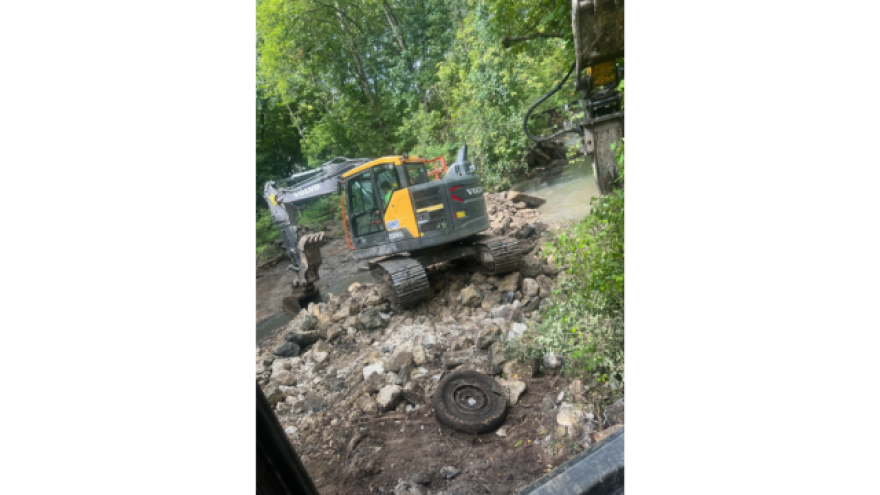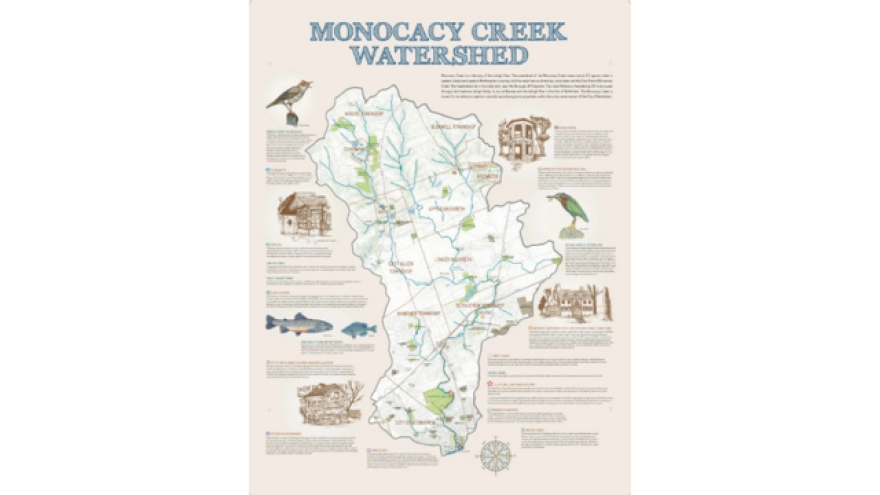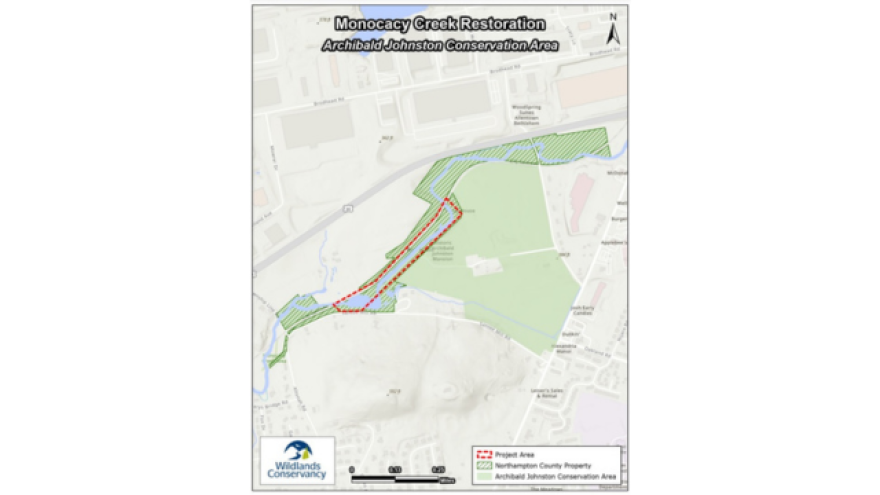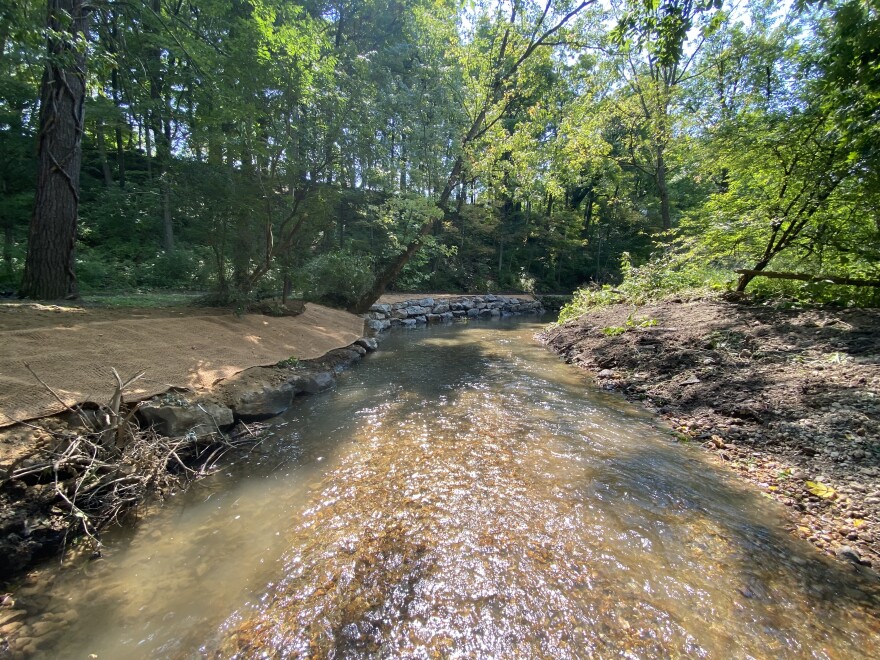BETHLEHEM TWP., Pa. — Almost a century ago, a portion of the Monocacy Creek running through the township was changed — the water was manipulated to flow differently, and bridges were added.
In one section, the creek was directed into a circle, for paddle boats.
“It was a very unique area, but, over time, there was no maintenance, and the stream was really degraded,” said Kristie Fach, Wildlands Conservancy's director of ecological restoration. “The structures were in disrepair, falling into the stream. In this reach, which is actually a high-quality cold water fishery and native reproducing trout stream, conditions should be cold, oxygenated water — great habitat — and, instead, that the conditions were really impaired.
“That's where we were looking at it, both from recreation and the safety hazard, but also just the water quality and the habitat improvement.”
Wildlands, along with Northampton County officials, last month announced a new project already underway that’s been in the works for a decade — restoring the half-mile section of the Monocacy Creek that runs through the Archibald Johnston Conservation Area. Funded through more than $300K in grants and county contributions, officials said it’s a similar process to recent work on the Bushkill Creek, and aims to improve the stream’s health by restoring the natural flow.
"The Monocacy Creek is a community treasure, and while it holds this state designation, the section that flows through Archibald Johnston is being significantly degraded by the old dams, access bridges, and crossing areas that were built long ago, long before water quality, habitat conservation and comprehensive watershed management planning were local priorities," said Northampton County Executive Lamont G. McClure, in a news release.
"Given their demonstrated stream restoration expertise, the county is extremely grateful to partner with Wildlands Conservancy to help advance the health of the Monocacy."

‘Nearly 50 square miles’
The Monocacy Creek, which flows into the Lehigh River near downtown Bethlehem, passes through Bushkill, Moore, East Allen, Upper Nazareth, Lower Nazareth and Hanover townships.
It is designated as a high-quality cold water and migratory fishery, and receives special protection under the Clean Water Act.
“The watershed of the Monocacy Creek covers nearly 50 square miles in eastern Lehigh and western Northampton counties, and the creek has two branches, main stem and the East Branch Monocacy Creek,” according to the Monocacy Creek Watershed Association’s website. “ … The Monocacy Creek is known for its ability to sustain a naturally reproducing trout population within the urban environment of the City of Bethlehem.”

However, like other Lehigh Valley waterways, the Monocacy has seen its share of pollution as development continues to steadily overtake green spaces across the region.
In 2022, environmental officials studied several of the Valley’s waterways, including the Lehigh River, Little Lehigh, Saucon, Bushkill and Monocacy creeks.
Each was found to contain different microplastic fragments, fibers or films — plastic pieces less than 5mm long, or smaller than a grain of rice — often residue from discarded or degraded plastic products such as clothing, hard plastics, bags, flexible packaging and cosmetic products.
And, the creek is still facing threats.
Earlier this year, residents during a public hearing argued against the state Department of Environmental Protection approving a wastewater permit for a 250,000-square-foot Hanover Township, Northampton County, warehouse project.
If the permit is approved, developers will be allowed to discharge stormwater from construction into the Monocacy Creek.
Residents who shared testimony focused on the need to protect the creek against stormwater runoff tainted with chemicals and sediment, as well as how an increase in impervious surfaces can contribute to flooding, especially after severe weather events.
No one spoke in favor of the project.
‘Restoring the stream almost immediately’
While creek restoration is well underway, the project “was in the works” for a long time, Fach said.
“The logistics were really tricky to figure out because the stream was so manipulated years ago,” she said. “We want to just make sure that we were going about it in the best way.
“The construction happened this year, but we've been looking at it for almost a decade.”
As part of the work, six structures were removed.
“The half mile includes the removal of six structures, whether they're bridges that have fallen into the stream, small dams that were diverting water flow and also a spring that had been impounded and was creating really stagnant conditions,” she said. “There's a half mile of restoration, and that includes removal of the structures, stream bank restoration and we also installed fish habitat structures.
“And there's the trail rehab, then invasive species management and planting with native species.”

Structures were removed last month, with restoration work completed within the past few days, she said. Work on the trail is slated next, before finally pulling out invasive species and planting natives in the spring.
"This is the first step in improving the environmental and recreational opportunities within AJCA,” said Bryan S. Cope, Northampton County’s superintendent of Parks and Recreation. “Although this is a small part of Monocacy Creek, it is very important to continue to provide accessible trails to the creek and improve the overall diversity and habitat that the creek supports.”
It’s already making a difference, Fach said.
“The great thing about stream restoration projects that involve dam removal is that you're restoring the stream almost immediately — there's a transition period, but you'll see improvement almost right away.”Kristie Fach, Wildlands Conservancy's director of ecological restoration
“You can already see that trout have better movement throughout the stream,” she said. “ … As soon as we removed it, and cool water was coming in, the contractors wanted to get the fishing poles out because the trout that were there were really big.
“The great thing about stream restoration projects that involve dam removal is that you're restoring the stream almost immediately — there's a transition period, but you'll see improvement almost right away.”


